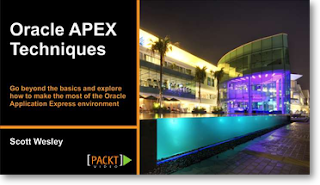Oracle Application Express for Mobile Web ApplicationsIf you haven't heard about this book yet, you're not reading enough media on-line.
APEX regulars
Roel Hartman,
Christian Rokitta and APEX product manager
David Peake are the published authors, but I think it’s safe to say we can also thank
Dan McGhan for starting the project.
(I mention Roel explicitly a few times where I'm pretty sure he was involved, sorry if I apply undue credit anywhere!)
I've been meaning to write this review for quite some time - I had the pleasure of technical reviewing this book & from the first chapter I knew this was going to be a winner - something very popular for anyone with half a brain that can bust out an APEX application.
Introduction to APEX for Mobile Development
Let’s be honest, the title alone sold the book for me. Mobile development is apparently kinda popular right now, as is APEX - so it seemed the perfect pair.
I think it was a great introduction to what’s expected out of mobile development, particularly through the eyes of an APEX developer. It details issues such as web vs native & responsive design. It should whet your appetite, if not - you’re in the wrong game ;-)
Creating Mobile Pages
This chapter starts of by de-constructing a basic jQuery Mobile page, which sets the scene well for the type of HTML to expect from these pages.
You are then walked through the creating of your ‘first’ mobile page using a list view and a basic form. The author then uses these to illustrate the many ways you can define navigation between pages, including a mobile dialog.
He then finishes with an intro to transitions, loading widgets and templates.
Highlights - realising the programmatic flexibility APEX can provide.Presenting Data through List Views
As I’ve learned in a current project developing an application for a tablet - list views are a fundamental cultural shift from the desktop, providing a standard workflow construct.
This chapter details the various options APEX provides when defining these lists views.
The author also includes some sample CSS to help show how to identify then manipulate components on the page - it’s not too hard once you are shown some examples.
Highlights - advanced formatting with CSS examples; swipe to deleteAccepting Input via Forms
This chapter starts with the simplest, most common form ever - the login page. The author notes how bland the stock form is, and uses the power of CSS to tart it up.
The next most important aspect of mobile development is discussed - grid layout.
Screen real estate is also precious, so there are some examples of collapsible content.
Also included are discussions regarding HTML5 input options such as the slider & toggle switch, and ways to enhance existing selectors such as radio groups and select lists.
I keep saying things are important, but mobile is a whole new world and notifications are another example of a fundamental product feature that needs re-addressing in the mobile world.
If you’re a fan of iOS, Roel continues the chapter by showing how to customise the delete dialog box with a native looking popup; then follows it up with a much nicer success confirmation.
If that’s not enough, the chapter puts finishing touches on your ‘first’ form to make it look ultra professional - and we’re only four chapters in!
Highlights - more CSS examples, grid layout, notificationsDisplaying Calendars and Charts
As if your application isn't looking sexy enough already, we can also add various charts and calendars.
Out of the box calendar’s are not too bad - but again Roel takes things a few steps further with some inspiration from iOS.
He doesn't go into too much detail with charts - they’re already pretty nifty and the APEX team are constantly working with
AnyChart to ensure greater capability and conformity with various devices. Later in the chapter though he demonstrates some of the other options out there such as Highcharts & Flotcharts - which includes an example of a RESTful web-service.
The surface is also skimmed with mapping options, but I think again it’s because of the reliance on external interfaces.
Highlights - calendar enhancementImplementing a Navigation Springboard
This chapter starts with an obvious lean towards Apple devices, but springs back to setting up a very nifty iconic menu (see what I did there?).
Roel then shows how to add tab navigation across the footer of your page - useful for certain applications but it could be considered dead real estate.
Shortly after he does detail how to move away from the typical HTML style buttons to iconic buttons in your header that you’d expect from a mobile application.
The coolest part of this chapter is a slide menu just like the one you see in Facebook mobile. He really puts list templates to work - one of my favourite APEX constructs.
Highlights - iconic menu with notification counters; sliding menuTheming Your Mobile Application
This is a small but useful chapter describing how to turn your application from a
royal blue to something more suitable to your client’s needs.
It’s also a chapter where I’ll claim a little credit for improvement. Changing swatches within templates can be tedious, so I suggested the author provide instructions to parameterise the templates with some form of substitution string - thereby making it easier to switch between swatches.
It finishes with a short piece on managing icons between devices using CSS media queries.
Highlights - media query exampleWorking with Dynamic Actions
Let’s face it, dynamic actions are one of the top 3 features of APEX. This is why I'm a little torn with the approach of this chapter - the first half is a simple breakdown of how dynamic actions work and how to use them, something that seemed a little below the target audience and previously presumed skill level of the reader (my perspective). I do, however, feel they’re vital to good applications and I'm glad there is another chance to show the community how they work.
The second half shows how dynamic actions have been modified for APEX 4.2, and introduces the new declarative events such as orientation change, scrolling, tapping & touching & swipes.
The author provides a few mobile specific examples of dynamic actions, then details some advanced topics such as non-standard selection types, event scope & custom events - all of which are also useful in desktop environments.
Given the style of the book so far, I was a little disappointed with this chapter - I think it had more potential than was delivered, with respect to whoever wrote this chapter.
Highlights - advanced dynamic action techniques.Deploying Applications Natively
If you want to interact with the hardware of your device using a toolkit such as
PhoneGap, you should buy this book for this chapter alone.
HTML5 is still catching up with hardware capability, and the various browsers are even further behind - so these types of interfaces allow you to embed your APEX application in a lower layer within a mobile device.
The chapter starts with a good philosophical discussion on native vs web vs hybrid applications, then describes the PhoneGap architecture.
From there it’s a step-by-step guide on configuring an Android Development environment for Cordova. iPhone users - there is also a section on cross-platform support.
It then shows how to use the PhoneGap APIs in your APEX pages using the device’s camera as an example.
Unfortunately I didn't have the time to implement an application natively during the technical review, partially because I had some laptop issues myself when this chapter was ready. The chapter is very detailed, however, and it will be front row & centre very shortly for when I do.
Highlights - all of it - I believe you can thank Christian for this oneSecuring your Mobile Application
I wouldn’t consider myself an expert in security, but I have a high level of interest - a
presentation I wrote on the topic won me best paper in 2011. So I was looking forward to reading the implications for mobile.
It’s a fairly concise chapter, covering SSL, idle sessions, encryption & session state protection. I think the best pages discuss application & schema splitting, getting the reader to think about these implications, but doesn’t go into a large amount of detail.
Highlights - timeout messaging techniquesConclusion
I think the book is excellent. It covers all the topics you think you’ll need for mobile development, and packs a whole bunch more.
I will say it started strong, but tapered off towards the end - but I think that may be due to the fact books are difficult to manage, author & produce while still maintaining some sort of life. Kudos to the authors involved.
It’s a little biased towards iPhones - evident because I own an Android, but there isn't much content that requires such a device. Of course, this is the nature of the real world, and considerations need to be made when developing applications for mobile devices - what is your target market?
You will also need patience. It’s bleeding edge material that sometimes requires supplementary files or Oracle database adjustments. If you’re still learning the power of jQuery & CSS (aren't we all?) then there may be times your code isn't quite right and it might take some time to work out, but it’s part of the learning process - it just demonstrates how valuable this book is.
Well done gang.If you're interested in more of my reviews,
check this out.





















